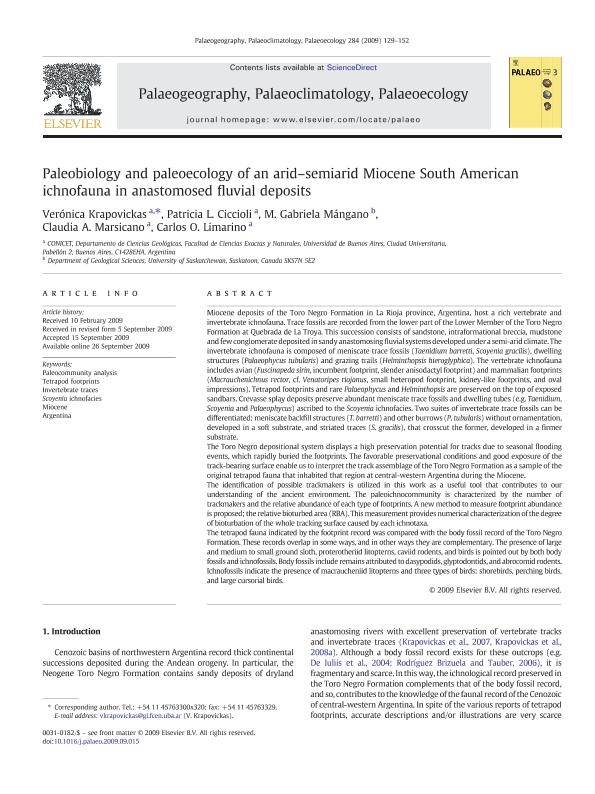Mostrar el registro sencillo del ítem
dc.contributor.author
Krapovickas, Verónica

dc.contributor.author
Ciccioli, Patricia Lucia

dc.contributor.author
Mangano, Maria Gabriela

dc.contributor.author
Marsicano, Claudia Alicia

dc.contributor.author
Limarino, Carlos Oscar

dc.date.available
2019-04-23T20:49:11Z
dc.date.issued
2009-12
dc.identifier.citation
Krapovickas, Verónica; Ciccioli, Patricia Lucia; Mangano, Maria Gabriela; Marsicano, Claudia Alicia; Limarino, Carlos Oscar; Paleobiology and paleoecology of an arid-semiarid Miocene South American ichnofauna in anastomosed fluvial deposits; Elsevier Science; Palaeogeography, Palaeoclimatology, Palaeoecology; 284; 3-4; 12-2009; 129-152
dc.identifier.issn
0031-0182
dc.identifier.uri
http://hdl.handle.net/11336/74876
dc.description.abstract
Miocene deposits of the Toro Negro Formation in La Rioja province, Argentina, host a rich vertebrate and invertebrate ichnofauna. Trace fossils are recorded from the lower part of the Lower Member of the Toro Negro Formation at Quebrada de La Troya. This succession consists of sandstone, intraformational breccia, mudstone and few conglomerate deposited in sandy anastomosingfluvial systems developed under a semi-arid climate. The invertebrate ichnofauna is composed of meniscate trace fossils (Taenidium barretti, Scoyenia gracilis), dwelling structures (Palaeophycus tubularis) and grazing trails (Helminthopsis hieroglyphica). The vertebrate ichnofauna includes avian (Fuscinapeda sirin, incumbent footprint, slender anisodactyl footprint) and mammalian footprints (Macrauchenichnus rector, cf. Venatoripes riojanus, small heteropod footprint, kidney-like footprints, and oval impressions). Tetrapod footprints and rare Palaeophycus and Helminthopsis are preserved on the top of exposed sandbars. Crevasse splay deposits preserve abundant meniscate trace fossils and dwelling tubes (e.g. Taenidium, Scoyenia and Palaeophycus) ascribed to the Scoyenia ichnofacies. Two suites of invertebrate trace fossils can be differentiated: meniscate backfill structures (T. barretti) and other burrows (P. tubularis) without ornamentation, developed in a soft substrate, and striated traces (S. gracilis), that crosscut the former, developed in a firmer substrate. The Toro Negro depositional system displays a high preservation potential for tracks due to seasonal flooding events, which rapidly buried the footprints. The favorable preservational conditions and good exposure of the track-bearing surface enable us to interpret the track assemblage of the Toro Negro Formation as a sample of the original tetrapod fauna that inhabited that region at central-western Argentina during the Miocene. The identification of possible trackmakers is utilized in this work as a useful tool that contributes to our understanding of the ancient environment. The paleoichnocommunity is characterized by the number of trackmakers and the relative abundance of each type of footprints. A new method to measure footprint abundance is proposed; the relative bioturbed area (RBA). This measurement provides numerical characterization of the degree of bioturbation of the whole tracking surface caused by each ichnotaxa. The tetrapod fauna indicated by the footprint record was compared with the body fossil record of the Toro Negro Formation. These records overlap in some ways, and in other ways they are complementary. The presence of large and medium to small ground sloth, proterotheriid litopterns, caviid rodents, and birds is pointed out by both body fossils and ichnofossils. Body fossils include remains attributed to dasypodids, glyptodontids, and abrocomid rodents. Ichnofossils indicate the presence of macraucheniid litopterns and three types of birds: shorebirds, perching birds, and large cursorial birds.
dc.format
application/pdf
dc.language.iso
eng
dc.publisher
Elsevier Science

dc.rights
info:eu-repo/semantics/openAccess
dc.rights.uri
https://creativecommons.org/licenses/by-nc-sa/2.5/ar/
dc.subject
ARGENTINA
dc.subject
INVERTEBRATE TRACES
dc.subject
MIOCENE
dc.subject
PALEOCOMMUNITY ANALYSIS
dc.subject
SCOYENIA ICHNOFACIES
dc.subject
TETRAPOD FOOTPRINTS
dc.subject.classification
Meteorología y Ciencias Atmosféricas

dc.subject.classification
Ciencias de la Tierra y relacionadas con el Medio Ambiente

dc.subject.classification
CIENCIAS NATURALES Y EXACTAS

dc.title
Paleobiology and paleoecology of an arid-semiarid Miocene South American ichnofauna in anastomosed fluvial deposits
dc.type
info:eu-repo/semantics/article
dc.type
info:ar-repo/semantics/artículo
dc.type
info:eu-repo/semantics/publishedVersion
dc.date.updated
2019-04-05T14:47:30Z
dc.journal.volume
284
dc.journal.number
3-4
dc.journal.pagination
129-152
dc.journal.pais
Países Bajos

dc.journal.ciudad
Amsterdam
dc.description.fil
Fil: Krapovickas, Verónica. Consejo Nacional de Investigaciones Científicas y Técnicas. Oficina de Coordinación Administrativa Ciudad Universitaria. Instituto de Geociencias Básicas, Aplicadas y Ambientales de Buenos Aires. Universidad de Buenos Aires. Facultad de Ciencias Exactas y Naturales. Instituto de Geociencias Básicas, Aplicadas y Ambientales de Buenos Aires; Argentina
dc.description.fil
Fil: Ciccioli, Patricia Lucia. Consejo Nacional de Investigaciones Científicas y Técnicas. Oficina de Coordinación Administrativa Ciudad Universitaria. Instituto de Geociencias Básicas, Aplicadas y Ambientales de Buenos Aires. Universidad de Buenos Aires. Facultad de Ciencias Exactas y Naturales. Instituto de Geociencias Básicas, Aplicadas y Ambientales de Buenos Aires; Argentina
dc.description.fil
Fil: Mangano, Maria Gabriela. University of Saskatchewan; Canadá. Consejo Nacional de Investigaciones Científicas y Técnicas; Argentina
dc.description.fil
Fil: Marsicano, Claudia Alicia. Consejo Nacional de Investigaciones Científicas y Técnicas. Oficina de Coordinación Administrativa Ciudad Universitaria. Instituto de Geociencias Básicas, Aplicadas y Ambientales de Buenos Aires. Universidad de Buenos Aires. Facultad de Ciencias Exactas y Naturales. Instituto de Geociencias Básicas, Aplicadas y Ambientales de Buenos Aires; Argentina
dc.description.fil
Fil: Limarino, Carlos Oscar. Consejo Nacional de Investigaciones Científicas y Técnicas. Oficina de Coordinación Administrativa Ciudad Universitaria. Instituto de Geociencias Básicas, Aplicadas y Ambientales de Buenos Aires. Universidad de Buenos Aires. Facultad de Ciencias Exactas y Naturales. Instituto de Geociencias Básicas, Aplicadas y Ambientales de Buenos Aires; Argentina
dc.journal.title
Palaeogeography, Palaeoclimatology, Palaeoecology

dc.relation.alternativeid
info:eu-repo/semantics/altIdentifier/doi/http://dx.doi.org/10.1016/j.palaeo.2009.09.015
dc.relation.alternativeid
info:eu-repo/semantics/altIdentifier/url/https://www.sciencedirect.com/science/article/pii/S0031018209003964
Archivos asociados
